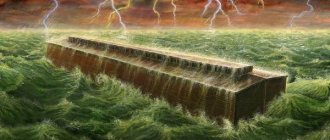Thanks to Noah and his obedience to God, the human race did not perish during the global flood, animals and birds were saved. A wooden ship 147 meters long and smeared with resin, at the behest of God, saved living creatures from the raging elements. The famous biblical legend haunts people to this day.
Sensational itch
This disease can affect anyone.
Even a doctor. After all, nothing foreshadowed trouble when, in the middle of the last century, the unremarkable and unknown American anesthesiologist Ron Wyatt suddenly became “infected” with it. It is he who owns the most popular hypothesis about the existence of Noah's Ark. She was born after Ron got his hands on an issue of Life magazine from 1957 with published photographs of the surroundings of the Tendyurek stratovolcano in the Ararat Mountains (remember, it was in the Ararat Mountains, according to the Bible, that Noah landed with his ark). It was in this area that Turkish army captain Ilham Durupinar took his famous photographs from an airplane, which depict strange formations resembling the remains of the ark. The muse of distant travels, as we know, attracts a person. She tore Father Fyodor out of his quiet provincial monastery, and forced anesthesiologist Ron Wyatt to look for the ark in the mountains of Ararat. And the tireless Ron found him. Or rather, only the place that the Turkish pilot photographed. Surrounding the boat-shaped trail were what appeared to be clay walls, which Wyatt declared to be the woody remains of the ark. After him, all the ark hunters repeated the same thing, immediately joining the ranks of the faithful “Wyattists.”
The photo that changed the fate of Dr. Wyatt / ©Flickr
However, geologists have their own opinion on this matter.
“For me, as a geologist, their belief that this is a tree is incomprehensible,” says geology professor Larry Collins. – The chaotic pattern of the presented samples of this “wood” has nothing to do with the structure of petrified wood. In addition, petrified wood is very hard because the wood cells are replaced over time by silicate molecules commonly known as quartz. Quartz, like diamond, is incredibly hard. The sample given to me does not possess this quality.
One of the creationists, underwater discovery expert David Fasseld, who, at Wyatt’s insistence, provided the sample to geologist Larry Collins, after the latter’s conclusion even stopped writing his book about the ark, admitting that Wyatt’s conclusions were wrong. The same cannot be said about Ron Wyatt himself, who was fanatically “confident” until the end of his days. Just like the rest of the miracle hunters.
“Looking at this photo, the first thing I thought was that it was a small protrusion in the rock, since there was another similar protrusion visible there,” admits geologist from Boston University Farouk El-Baz. “The stones slid down, forming a ditch, and this is clearly visible in the picture. I doubt this is the work of man.
Slope of Ararat: another ark? / ©Flickr
The length of the desired object in the area of the Tendyurek volcano is 157 meters. The length of Noah's Ark, according to the Bible, is 300 cubits (137 meters). A follower of Wyatt, one Jerry Bowen, finds an explanation for this difference. Moses, who wrote the Book of Genesis, studied in Egypt, and he apparently had in mind a measure of length called the royal Egyptian cubit. Thus, the difference in the end is not twenty meters, but only a few centimeters.
However, the size of the “elbows” varies greatly. And if you really want it, anything is possible. See a human face on Mars, declare the Nazca desert an airfield for flying saucers and see petroglyphs in the form of spacesuits in the walls of the Egyptian pyramids.
– Why are we surprised that our expectations of seeing a ship on Mount Ararat were crowned with success? – says Russian researcher Vadim Chernobrov. – Moreover, as many as three images of him were found in different places.
Despite everything, these too are just general phrases. Let's look into it in detail.
Ararat is the highest volcanic massif of the Armenian Highlands. It consists of two cones of extinct volcanoes merging at their bases: Greater Ararat and Little Ararat. The height of the Bolshoi is 5165 m above sea level / ©Wikimedia Commons
About half a century ago, in one of the glacial crevices on Ararat, at an altitude of 4 km, French archaeologists found another wooden artifacts. They were later dated to 800 BC. - at times ancient, but much later than the supposed voyage of Noah. The tree may have been raised to a height for construction that was never completed.
Noah's Ark - fact or fiction?
The debate about whether Noah's Ark really existed or is just a beautiful biblical legend continues to this day. Detective fever affected not only scientists. American anesthesiologist Ronn Wyatt was so inspired by photographs published in Life magazine in 1957 that he set out to find Noah's Ark.
The photo taken by a Turkish pilot in the Ararat Mountains showed a boat-shaped trail. An enthusiast, Wyatt retrained as a biblical archaeologist and found that place. The controversy did not subside - what Wyatt declared to be the remains of Noah's Ark, that is, petrified wood, according to geologists, was nothing more than clay.
Ron Wyatt has a whole crowd of followers. Later, new photographs were published from the “mooring” site of the famous biblical ship. All of them depicted only outlines that resembled the shape of a boat. All this could not fully satisfy scientific researchers, who even questioned the existence of the famous ship.
Noah's destroyer
“And you shall make it this way: the length of the ark is three hundred cubits; its breadth is fifty cubits, and its height thirty cubits.”
Neither more nor less (an elbow is approximately 50 cm), these are the dimensions of a modern destroyer or megayacht of an Arab sheikh. At 140 meters long, it would have been the largest ship in the entire ancient world. Backbreaking work for one family.
“Even in the 19th century they would not have been able to build such a ship from wood alone,” says shipbuilding expert Tom Vosmer. – Metal parts would be needed. At sea, such a vessel's hull will crack and leak. It would sink as quickly as an ordinary stone.
Perhaps Noah built the ark, only its dimensions were much more modest.
Jan Brueghel the Younger, “The Driving of Animals into Noah’s Ark” (XVII century) / ©Gallerix
Size of Noah's Ark
Genesis uses cubits, not feet or meters. A cubit in the Old Testament is approximately 45 centimeters. Another measurement to consider is the Egyptian royal cubit, which is 53 centimeters. As mentioned earlier, Moses is considered the author of the book of Genesis. Since Moses was educated in Egypt, we must consider the Egyptian cubit as well as the Hebrew cubit.
| title text | Hebrew cubit (meter) | Royal cubit (meter) |
| Length | 300 (133.35 m) | 300 (157.35 m) |
| Width | 50 (22.2 m) | 50 (26.2 m) |
| Height | 30 (13.3 m) | 30 (15.7 m) |
The ark's carrying capacity is the same as that of a modern cargo ship. The picture above shows a comparison with a 170 meter long cargo ship. The Ark had a volume of 40 thousand cubic meters and a capacity of 14,000 tons. This is the equivalent of 522 railway cars. The Ark could accommodate more than 125,000 sheep-sized animals. Interestingly, there are fewer than 18,000 species of land animals in existence today. Additionally, the average size of most animals is smaller than that of a sheep.
Each creature has a pair
“Bring also into the ark two of every living creature and every flesh, so that they may remain alive with you; let them be male and female. Of birds according to their kinds, and of livestock according to their kinds, and of every thing that creeps on the earth according to their kind, two of every kind will come to you, so that you may live.”
It is believed that our planet is inhabited by 30 million species of animals. Perhaps, after these words, comments seem unnecessary. If Noah had a whole fleet of “destroyers,” cramming in something that couldn’t be shoved in—“a couple” of each type (total 60 million individuals)—would have been worse than Landau’s problems. The same applies to loading “creatures”. According to Scripture, Noah and his family were able to accomplish this in a week. According to experts, at real speed this would take at least thirty years.
Perhaps the Bible does not mean all animals, but only those that lived in the area where Noah lived? The Book of Genesis describes specific species: seven pairs of ten species of “pure” animals (those that could be sacrificed to God): sheep, antelope, cattle, goats, deer. “Unclean” animals are also described there: pigs, hares, lizards, snails, etc. There are 30 species in total. In total, there should have been 260 individuals on board the ark. This is very small compared to 30 million (think 60 million), but much more realistic.
Another sensation related to Noah’s Ark appeared already in 2000, when satellite photographs of the slopes of Ararat were studied. In the saddle between its two peaks, under the snow, someone again saw the outline of a ship. Alas, scientists again considered this to be just an ordinary fold of a sliding glacier. In the end, experts are absolutely sure: under no circumstances could the ark remain frozen in the ice for so long. After all, the glacier moves and carries away everything on its way to the foot of the mountains. According to scientists, if the fragments of the ark were locked in the glacier, they would have been found not at the top, but at the base of Ararat.
No trace of the flood
“In the six hundredth year of Noah’s life, in the second month, on the seventeenth day of the month, on that day all the fountains of the great deep burst forth, and the windows of heaven were opened; and the rain poured on the earth for forty days and forty nights... And the water on the earth increased exceedingly, so that all the high mountains that were under the whole sky were covered... And the water increased on the earth for one hundred and fifty days.”
The whole legend of Noah makes no sense without the fact of the flood. The flood described in the Bible would invariably leave a very clear geological mark, visible throughout the world. His search began a century and a half ago. Geologist Lan Plimer searched for it on all continents, but in vain. However, not entirely. He, like many others, managed, rather, to prove that nothing like this had ever happened.
But that's not all. The very idea of a flood negates everything that science knows about the history of the Earth. To flood the planet to the heights of the Himalayas, a volume of water is needed three times greater than that available in all the oceans. Where did it come from then? “... all the sources of the great deep burst open,” Scripture suggests.
“It cannot be that water in such a volume comes from geysers and underground springs,” says Lan Plimer. – If this happened, then it would no longer be water, but swamp slurry, in which it is impossible to swim. In addition, flooding the entire surface of the planet would lead to changes in the Earth's atmosphere. So much steam would enter the atmosphere that a person would choke while breathing, and the pressure would increase so much that it would burst the lungs. And the geyser emissions contain sulfur dioxide, so people would have suffocated even before the flood began.
In 1949, the CIA conducted aerial photography of Ararat. For many years, these photographs were classified, access to them was opened only in 1995. In the photographs you can see a certain dark mass, the length of which is 140 m, almost the exact size of the ark. However, geologists declared these photographs inconclusive, citing extremely low image quality. The “dark mass” in the photographs can be either melted snow or a simple play of light and shadow.
Why did Noah start building the ark?
Despite many years of tireless calls from Noah to leave idolatry, to stop tyranny of each other, arrogance, debauchery, etc., the majority of people not only did not listen to his words, but also openly threatened him with violence. Some legends tell how they mocked him: they beat him until he lost consciousness, strangled him, and threw stones at him. Only a few left their idols and followed Noah. And when he received the revelation that no one else from his people would believe in the Truth, Noah turned to God with a prayer that none of the unbelievers would remain on earth, although he admonished his fellow countrymen to the last.
Noah, Gilgamesh and Atrahasis
At one time, philologists also became involved in the investigation of the ark. Having studied the language of the legend of Noah, they came to the conclusion that it was written in the 6th century BC. It was inserted into the Torah by Jewish priests who lived in Babylon (modern Iraq - author's note). There is a possibility that it was they who composed the beautiful parable. But scientists are well aware that any of such legends always contains a certain amount of truth. Perhaps the story of Noah's Ark is just an exaggerated retelling of real events.
One hundred and fifty years ago, the Englishman Henry Laird studied the ruins of the Babylonian library in Nineveh. Having discovered hundreds of cuneiform tablets, he sent them to the British Museum, where appropriate specialists could work with them. However, the museum workers did not attach importance to the next batch of clay books and sent them to the storerooms. They were kept there until 1872, when museum employee George Smith found them and deciphered them. His conclusion turned out to be truly sensational. He discovered similarities between the famous “Epic of Gilgamesh” and the biblical legend of our Noah.
"Noah's Ark". Illustration by Gustave Doré / ©Wikimedia
Then everything went like clockwork. A lot of archaeological and geological expeditions were organized into the territory of Iraq. They all confirmed that there really was a serious flood in this region. It happened at least five thousand years ago in Mesopotamia. But it was there that the civilizations of Sumer, Assyria and Babylon arose. To them we owe the Epic of Gilgamesh, as well as the predecessor of this legend - the epic of the Sumerian hero Atrahasis. All these people, like Noah, with enviable constancy heed the voice of the gods, build a raft and save themselves on it. In addition, both epics tell about a real flood in Mesopotamia, which, as we have already said, happened five thousand years ago.
Therefore, scientists suggest that the legend of Noah is only a Christian version of a pagan epic written shortly after the above-mentioned flood. The latter washed away many cities of Mesopotamia, but, of course, not the whole world. Meanwhile, scientist Alan Milord is confident that the Bible says nothing about the Flood:
– In Hebrew, the words “land” and “country” were written the same way. It can be assumed that it describes a local flood.
The puzzle is probably complete.
Was there a Noah?
Scientists answer: “It may very well be.” Only if we take into account the above logical chain, we will have to cross out the familiar image of the biblical Noah, who historically was probably a completely different person.
He was a Sumerian. This means he shaved his head, painted his eyebrows and wore a skirt. This was customary in the Sumerian culture. How did this man live? The Epic of Gilgamesh says that he had both gold and silver. It turns out that Noah was not a simple winemaker at all, he was a merchant. Instead of an ark, he most likely had a large barge, perfect for transporting livestock, grain, beer and other goods. Shopping centers in those parts lay along the banks, so transporting goods by water was easier and cheaper.
How big was Noah's barge? Scientists have not yet found accurate descriptions of Sumerian trading barges, so they are simply estimating the maximum possible size of such a vessel at that time.
“The Epic of Gilgamesh says that the boat was divided into sections,” comments Tom Vosmer, an expert on ancient ships. – Large ships could be built like pontoons. Several barges, for example, were tied together with ropes, and on top was the house of the ship's owner.
Perhaps Noah lived on this ship with his family and could have loaded animals onto it for sale. When this ship was “moored”, and Noah and his family were just on it (according to different versions, this was the moment of some kind of celebration), a hurricane wind broke the rope and carried the barge along the waters of the Euphrates River.
Satellite image of the area in one of the areas of the Ararat Mountains, where the remains of Noah’s Ark are believed to have been found / ©Wikimedia
Scientists know that melting snow in the mountains of Armenia in July increases the water level in the Euphrates. At this time, the channels become passable for ships. Noah waited for such a flood to set off along the river with his goods. If we assume that a strong storm occurred at this time, then the Euphrates could turn into a raging sea, causing floods. However, it rarely rains in these places in July, so such floods occur no more often than about once every thousand years (it is not surprising that such events were necessarily recorded in the chronicles). In those days, the climate in these regions was hotter and more humid, and therefore hurricanes and downpours were stronger than now. If such a storm coincided with the melting of snow in the mountains, it could flood the entire Mesopotamian plain. Which is probably what happened.
But the Bible writes about 40 days and nights when the rain poured and “the windows of heaven were opened.” The Babylonian epic is more modest: it tells only about seven days. But even this week would be enough to “exterminate people from the face of the earth.” Perhaps, Noah’s barge, torn from the shore by a hurricane, actually drifted for quite a long time, but not on the fresh waves of the Euphrates, but on the sea. After all, the Babylonian text states: the water overboard became salty. Scientists calculated the barge's course across the flooded plain and concluded that it had apparently been carried into the Persian Gulf. It is unknown how long Noah's family swam around the bay. If you believe the Bible - a year, if the Sumerian epic - seven days. The latter version, of course, is much more likely. Noah's barge most likely carried beer, which had been brewed here since time immemorial. Noah's relatives and himself drank it instead of water. But the Sumerian Noah hardly wanted to return after the flood back to his native Sumerian city of Shurupak. According to Sumerian law, anyone who owed money and could not repay the debt was invariably enslaved. Being a merchant, Noah probably owed money, and having “burnt” in the flood, he was unable to make a profit, and he had nothing with which to repay the debt. However, according to Babylonian sources, Noah was none other than the head of the city of Shurupak. But this didn’t change anything either. Sumerian laws were equal for everyone.
Noah's further life is shrouded in mystery. But one of the Babylonian tablets still says that Noah remained in the land of Dilmun (now the island of Bahrain - author's note), but Noah's barge could not have ended up in the mountains of Ararat after the flood. There are a lot of unexplored burial grounds on the island of Bahrain. Who knows, maybe one of them still holds the remains of the legendary Noah?










